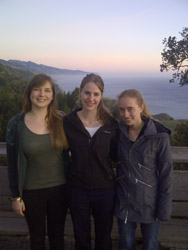MIT Undergrads Aid Research in Mechanical & Aero Engineering at Naval Postgraduate School
-
-
slice.mit.edu
Filed Under
Recommended

Three MIT students, Carolyn Coyle (mechanical engineering), Larissa Kunz (chemical engineering) , and Maggie Kane (aero/astro), spent the month of January completing an externship in Monterey, California, working at the Naval Postgraduate School (NPS). Their extern sponsor* was Professor Knox Millsaps SM '87, PhD '92, chair of the Department of Mechanical and Aerospace Engineering.
The first two days were spent getting checked in and touring the department's extensive research facilities and laboratories in power, energy and propulsion, space and satellite systems, guidance, navigation and control of autonomous vehicles, material science, and applied and experimental mechanics. Many faculty were involved in showcasing their labs and thesis students' research. Carolyn, Larissa, and Maggie then selected research projects to work on that aligned with their interests.
Carolyn: I worked with Professor Millsaps and Professor Jonathan Phillips to create a thermodynamic model of a Trident missile gas discharge system that predicts flow temperature and pressure behaviors as functions of time. I spent most of my time in the computer lab, combing my knowledge of thermal fluids engineering and technical computing to write code that solves a system of coupled, differential equations in Engineering Equation Solver (EES), a processing program with built-in real fluid property tables. The model will be used as a template that can be modified and used to characterize many specific projects in the future.

Larissa: I worked on a diesel engine in the marine propulsion laboratory. I gained CAD experience designing an adaptor to secure a pressure sensor in the head of the engine. This sensor is to be used in the research of the combustion of biofuels and in the use of a transient plasma ignition system in this diesel engine. Doug Seivwright, with whom I was working directly, also had me help set up a data acquisition system to record sensor measurements electronically. I was fortunate enough to get some hands-on experience as well, when I helped put the engine back together after it was modified for experimentation and participated in a Cold Spray Unit training in a neighboring laboratory.
Maggie: I worked at the turbo propulsion lab creating a program to facilitate the importation of data from a program in MATLAB to Solid Edge to expedite the iteration of splintered blade axial rotor compressors to allow for easier analysis of fluid-dynamic properties. This program will be used by graduate students at NPS as they work towards a design that will allow for greater efficiency in airplanes. I also had the opportunity to tour the facilities, including the Turbo Lab's wind tunnel. I was lucky enough to be able to learn about MATLAB in a practical environment, as it is a skill that I will continue to use throughout my time at MIT.
In addition to working in our respective labs at NPS, Professor Millsaps took us to visit other nearby research facilities. We visited the Monterey Bay Aquarium Research Institute, where Jim Bellingham '84, SM '84, PhD '88, the director of research and CTO, led us on a tour during which we learned about the development of vehicles to remotely explore the oceans. We also visited the marine meteorology division of the Monterey branch of the Naval Research Laboratory, one of the world leaders in numerical weather prediction. Simon Cheng, the lab's technical director, and various experts presented about specialized weather forecasting, advanced algorithms, and modeling techniques. Our externship concluded with a farewell barbeque in the beautiful California sunshine.
*Editor's note: This is part of a series of posts from MIT students and alumni who were involved in the 2012 Student/Alumni Externship Program, which connected current students to alumni in workplaces worldwide during MIT's Independent Activities Period. Alumni, learn how to get involved. This is just one way for alumni to interact with MIT students. Learn about other opportunities.






